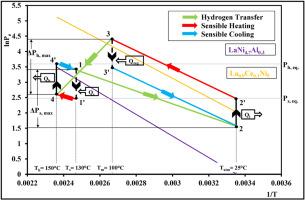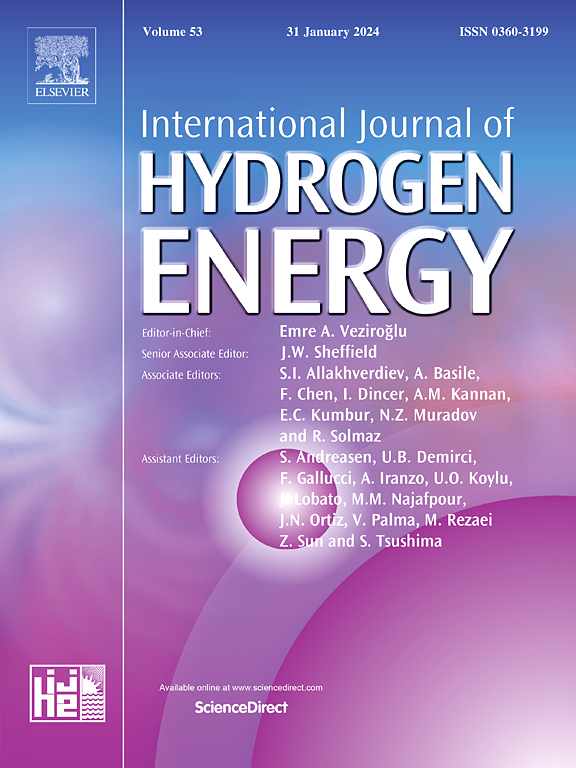铈、铝、锰和锡取代LaNi5氢化物热化学储能系统的性能研究
IF 8.1
2区 工程技术
Q1 CHEMISTRY, PHYSICAL
引用次数: 0
摘要
存储太阳能热能的必要性引起了人们对储能系统(ESS)发展的关注,这可以通过实施金属氢化物(MH)储能系统(MHESS)来解决。金属氢化物储能系统的成功运行取决于所采用的金属氢化物的性质,而金属氢化物的性质随其组成的变化而变化。因此,本文从储氢容量(HSC)、反应焓、工作温度和压力等方面研究了铝(Al)、锰(Mn)和锡(Sn)取代镍(Ni)和铈(Ce)取代镧(La)对LaNi5性能的影响,进而对金属氢化物储能系统性能的影响。利用内部Sievert装置通过体积法测量了金属氢化物的性能,观察到在20°C下,取代铈(1.48 wt%, 6.26 bar)的储氢容量和平衡压力高于取代铝(1.43 wt%, 0.81 bar)、锰(1.44 wt%, 0.9 bar)和锡(1.4 wt%, 0.17 bar)的储氢容量和平衡压力。相反,反应焓的变化趋势正好相反。利用这些金属氢化物的性质,利用La0.9Ce0.1Ni5 - LaNi4.7Al0.3、LaNi4.7Mn0.3 - LaNi4.7Sn0.3和La0.9Ce0.1Ni5 - LaNi4.7Sn0.3的金属氢化物组合,估计了在25°C、100°C、130°C和150°C下运行的金属氢化物储能系统的热力学性能。性能系数(COP)分别为0.49、0.46和0.54。基于驱动压力和热力学性能,La0.9Ce0.1Ni5 - LaNi4.7Sn0.3复合材料更适合于金属氢化物储能系统,其储能能量为2439.69 kJ,存储10 kg金属氢化物。本文章由计算机程序翻译,如有差异,请以英文原文为准。

Performance investigations on thermochemical energy storage system using cerium, aluminium, manganese, and tin-substituted LaNi5 hydrides
The necessity to store solar thermal energy draws attention to the development of energy storage systems (ESS), which can be addressed by the implementation of metal hydride (MH) energy storage systems (MHESS). The successful operation of metal hydride energy storage systems depends on the properties of the metal hydrides employed, which vary with compositional changes. Therefore, in the present work, the influence of the substitution of Aluminium (Al), Manganese (Mn), and Tin (Sn) for Nickel (Ni) and Cerium (Ce) for Lanthanum (La) on LaNi5 properties is studied in terms of hydrogen storage capacity (HSC), reaction enthalpy, working temperature, and pressure, and consequently on metal hydride energy storage system performance. The metal hydride properties were measured through the volumetric method using an in-house Sievert's Apparatus, and it was observed that the hydrogen storage capacity and equilibrium pressure are higher in the case of Cerium (1.48 wt%, 6.26 bar) substitution than those for Aluminum (1.43 wt%, 0.81 bar), Manganese (1.44 wt%, 0.9 bar), and Tin (1.4 wt%, 0.17 bar) at 20 °C. In contrast, the opposite trend was observed for reaction enthalpies. These metal hydride properties are applied to estimate the thermodynamic performance of metal hydride energy storage systems operating at 25 °C, 100 °C, 130 °C, and 150 °C using the metal hydride combination of La0.9Ce0.1Ni5 – LaNi4.7Al0.3, LaNi4.7Mn0.3 – LaNi4.7Sn0.3 and La0.9Ce0.1Ni5 – LaNi4.7Sn0.3. The coefficient of performance (COP) is observed to be 0.49, 0.46, and 0.54, respectively. Based on available driving pressure and thermodynamic performance, the combination of La0.9Ce0.1Ni5 – LaNi4.7Sn0.3 is observed to be more suitable for metal hydride energy storage systems with energy storage of 2439.69 kJ for 10 kg of metal hydrides.
求助全文
通过发布文献求助,成功后即可免费获取论文全文。
去求助
来源期刊

International Journal of Hydrogen Energy
工程技术-环境科学
CiteScore
13.50
自引率
25.00%
发文量
3502
审稿时长
60 days
期刊介绍:
The objective of the International Journal of Hydrogen Energy is to facilitate the exchange of new ideas, technological advancements, and research findings in the field of Hydrogen Energy among scientists and engineers worldwide. This journal showcases original research, both analytical and experimental, covering various aspects of Hydrogen Energy. These include production, storage, transmission, utilization, enabling technologies, environmental impact, economic considerations, and global perspectives on hydrogen and its carriers such as NH3, CH4, alcohols, etc.
The utilization aspect encompasses various methods such as thermochemical (combustion), photochemical, electrochemical (fuel cells), and nuclear conversion of hydrogen, hydrogen isotopes, and hydrogen carriers into thermal, mechanical, and electrical energies. The applications of these energies can be found in transportation (including aerospace), industrial, commercial, and residential sectors.
 求助内容:
求助内容: 应助结果提醒方式:
应助结果提醒方式:


